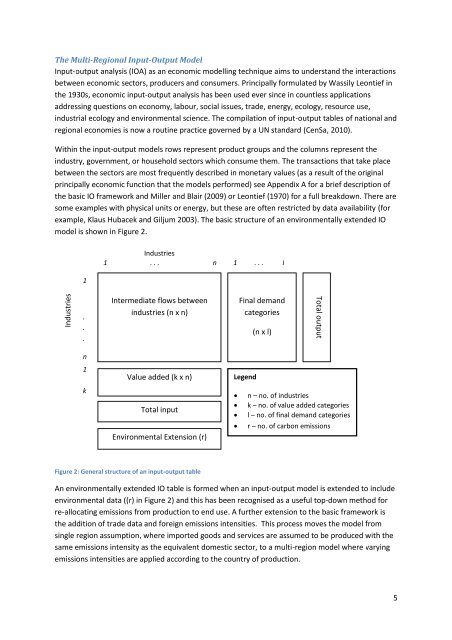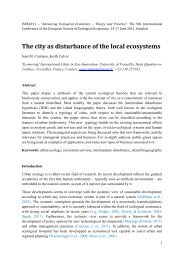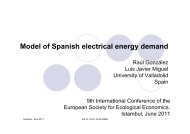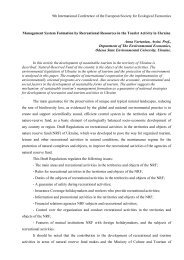Full Paper - ESEE 2011 - Advancing Ecological Economics
Full Paper - ESEE 2011 - Advancing Ecological Economics
Full Paper - ESEE 2011 - Advancing Ecological Economics
Create successful ePaper yourself
Turn your PDF publications into a flip-book with our unique Google optimized e-Paper software.
The Multi-Regional Input-Output Model<br />
Input-output analysis (IOA) as an economic modelling technique aims to understand the interactions<br />
between economic sectors, producers and consumers. Principally formulated by Wassily Leontief in<br />
the 1930s, economic input-output analysis has been used ever since in countless applications<br />
addressing questions on economy, labour, social issues, trade, energy, ecology, resource use,<br />
industrial ecology and environmental science. The compilation of input-output tables of national and<br />
regional economies is now a routine practice governed by a UN standard (CenSa, 2010).<br />
Within the input-output models rows represent product groups and the columns represent the<br />
industry, government, or household sectors which consume them. The transactions that take place<br />
between the sectors are most frequently described in monetary values (as a result of the original<br />
principally economic function that the models performed) see Appendix A for a brief description of<br />
the basic IO framework and Miller and Blair (2009) or Leontief (1970) for a full breakdown. There are<br />
some examples with physical units or energy, but these are often restricted by data availability (for<br />
example, Klaus Hubacek and Giljum 2003). The basic structure of an environmentally extended IO<br />
model is shown in Figure 2.<br />
Industries<br />
1<br />
.<br />
.<br />
.<br />
n<br />
1<br />
k<br />
1<br />
Industries<br />
. . . n<br />
Intermediate flows between<br />
industries (n x n)<br />
Value added (k x n)<br />
Total input<br />
Environmental Extension (r)<br />
Figure 2: General structure of an input-output table<br />
1 . . . l<br />
Final demand<br />
categories<br />
Legend<br />
(n x l)<br />
An environmentally extended IO table is formed when an input-output model is extended to include<br />
environmental data ((r) in Figure 2) and this has been recognised as a useful top-down method for<br />
re-allocating emissions from production to end use. A further extension to the basic framework is<br />
the addition of trade data and foreign emissions intensities. This process moves the model from<br />
single region assumption, where imported goods and services are assumed to be produced with the<br />
same emissions intensity as the equivalent domestic sector, to a multi-region model where varying<br />
emissions intensities are applied according to the country of production.<br />
Total output<br />
n – no. of industries<br />
k – no. of value added categories<br />
l – no. of final demand categories<br />
r – no. of carbon emissions<br />
5







